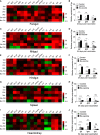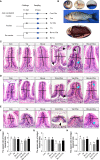Gut mucosal immune responses and protective efficacy of oral yeast Cyprinid herpesvirus 2 (CyHV-2) vaccine in Carassius auratus gibelio
- PMID: 35967417
- PMCID: PMC9373009
- DOI: 10.3389/fimmu.2022.932722
Gut mucosal immune responses and protective efficacy of oral yeast Cyprinid herpesvirus 2 (CyHV-2) vaccine in Carassius auratus gibelio
Abstract
Cyprinid herpesvirus 2 (CyHV-2) causes herpesviral hematopoietic necrosis (HVHN) disease outbreaks in farmed Cyprinid fish, which leads to serious economic losses worldwide. Although oral vaccination is considered the most suitable strategy for preventing infectious diseases in farmed fish, so far there is no commercial oral vaccine available for controlling HVNN in gibel carp (C. auratus gibelio). In the present study, we developed for the first time an oral vaccine against CyHV-2 by using yeast cell surface display technology and then investigated the effect of this vaccine in gibel carp. Furthermore, the protective efficacy was evaluated by comparing the immune response of a single vaccination with that of a booster vaccination (booster-vaccinated once 2 weeks after the initial vaccination). Critically, the activities of immune-related enzymes and genes expression in vaccine group, especially in the booster vaccine group, were higher than those in the control group. Moreover, strong innate and adaptive immune responses could be elicited in both mucosal and systemic tissues after receipt of the oral yeast vaccine. To further understand the protective efficacy of this vaccine in gibel carp, we successfully developed the challenge model with CyHV-2. Our results showed the relative percent survival was 66.7% in the booster vaccine group, indicating this oral yeast vaccine is a promising vaccine for controlling CyHV-2 disease in gibel carp aquaculture.
Keywords: CyHV-2; gibel carp; mucosal immune response; oral vaccination; protective efficacy; yeast surface display.
Copyright © 2022 Dong, Mu, Kong, Qin, Zhou, Wang, Cheng, Luo, Ai and Xu.
Conflict of interest statement
Author Y-ZL and T-SA was employed by the company Wuhan Chopper Fishery Bio-Tech Co., Ltd. The remaining authors declare that the research was conducted in the absence of any commercial or financial relationships that could be construed as a potential conflict of interest. The reviewer NW declared a shared affiliation with the authors ZX and WK to the handling editor at the time of review.
Figures







Similar articles
-
Yeast oral vaccines against infectious diseases.Front Microbiol. 2023 Apr 17;14:1150412. doi: 10.3389/fmicb.2023.1150412. eCollection 2023. Front Microbiol. 2023. PMID: 37138614 Free PMC article. Review.
-
β-glucan and anisodamine can enhance the immersion immune efficacy of inactivated cyprinid herpesvirus 2 vaccine in Carassius auratus gibelio.Fish Shellfish Immunol. 2020 Mar;98:285-295. doi: 10.1016/j.fsi.2020.01.025. Epub 2020 Jan 18. Fish Shellfish Immunol. 2020. PMID: 31962149
-
An attenuated strain of cyprinid herpesvirus 2 as a vaccine candidate against herpesviral hematopoietic necrosis disease in gibel carp, Carassius auratus gibelio.Fish Shellfish Immunol. 2023 Jul;138:108826. doi: 10.1016/j.fsi.2023.108826. Epub 2023 May 16. Fish Shellfish Immunol. 2023. PMID: 37201732
-
Immune response and protection in gibel carp, Carassius gibelio, after vaccination with β-propiolactone inactivated cyprinid herpesvirus 2.Fish Shellfish Immunol. 2016 Feb;49:344-50. doi: 10.1016/j.fsi.2016.01.003. Epub 2016 Jan 6. Fish Shellfish Immunol. 2016. PMID: 26772479
-
Current knowledge and future prospects of vaccines against cyprinid herpesvirus 3 (CyHV-3).Fish Shellfish Immunol. 2019 Oct;93:531-541. doi: 10.1016/j.fsi.2019.07.079. Epub 2019 Jul 29. Fish Shellfish Immunol. 2019. PMID: 31369858 Review.
Cited by
-
An Introduction to Relevant Immunology Principles with Respect to Oral Vaccines in Aquaculture.Microorganisms. 2023 Dec 4;11(12):2917. doi: 10.3390/microorganisms11122917. Microorganisms. 2023. PMID: 38138061 Free PMC article. Review.
-
Modulation of immune genes in the mucosal-associated lymphoid tissues of cobia by Sarcodia suae extract.Vet Res Commun. 2023 Dec;47(4):1973-1990. doi: 10.1007/s11259-023-10152-8. Epub 2023 Jun 23. Vet Res Commun. 2023. PMID: 37349590
-
Proteogenomic analysis of Cyprinid herpesvirus 2 using high-resolution mass spectrometry.J Virol. 2025 May 20;99(5):e0196024. doi: 10.1128/jvi.01960-24. Epub 2025 Apr 2. J Virol. 2025. PMID: 40172206 Free PMC article.
-
Generation and Characterization of ORF55/ORF57-Deleted Recombinant Cyprinid herpesvirus 2 Mutants with Chimeric Capsid Protein Gene of Grouper Nervous Necrosis Virus.Vaccines (Basel). 2023 Dec 30;12(1):43. doi: 10.3390/vaccines12010043. Vaccines (Basel). 2023. PMID: 38250856 Free PMC article.
-
Yeast oral vaccines against infectious diseases.Front Microbiol. 2023 Apr 17;14:1150412. doi: 10.3389/fmicb.2023.1150412. eCollection 2023. Front Microbiol. 2023. PMID: 37138614 Free PMC article. Review.
References
-
- Fisheries Bureau . China Fishery statistical yearbook. Beijing: China Agriculture Press; (2021).
-
- Sumithra TG. Cyprinid herpesvirus-2 (CyHV-2): a comprehensive review. Rev Aquacult (2021) 13(2):796–821. doi: 10.1111/raq.12499 - DOI
-
- Jung SJ, Miyazaki T. Herpesviral haematopoietic necrosis of goldfish, carassius auratus (L.). J Fish Dis (1995) 18(3):211–20. doi: 10.1111/j.1365-2761.1995.tb00296.x - DOI
Publication types
MeSH terms
Substances
Supplementary concepts
LinkOut - more resources
Full Text Sources
Medical
Research Materials

